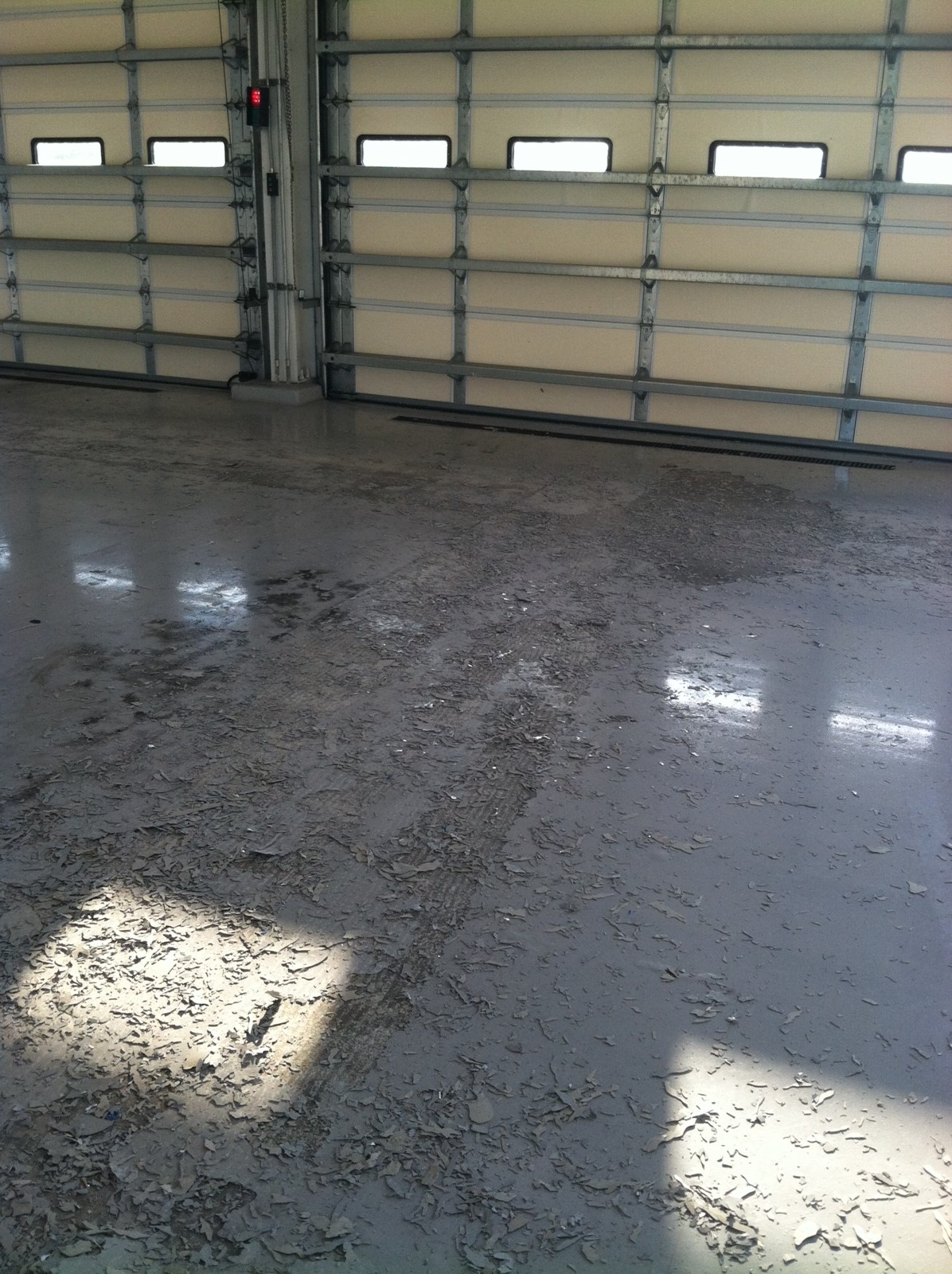Surface preparation is a vital part of all coatings jobs. Without a properly prepared surface, even the best coating system can and will fail. Industry veteran Pat Sicilia of Industrial Flooring Specialists has seen many jobs over the years where poor surface preparation has led to coatings failures, but one in particular stands out. Sicilia and his crew were recently called in to rescue the floor of a fire station in a major city in Florida. Once they arrived on the scene, it was extremely apparent that improper surface preparation was the culprit behind this flooring disaster.
Fire House Investigation
Under the best circumstances, fire station floors take a beating. Between the heavy vehicles that drive in and out of the area and the exposure to high volumes of water and abrasive chemicals, there is little room for error when it comes to surface prep and choosing the right coating system. “When we got to the fire station, we could t ell that the existing coating system had been put down with very little surface preparation. There were many areas of the floor where the coating was bubbling up. The original coating never bonded well with the substrate,” stated Sicilia.
ell that the existing coating system had been put down with very little surface preparation. There were many areas of the floor where the coating was bubbling up. The original coating never bonded well with the substrate,” stated Sicilia.
And the issues with the coating system didn’t stop there. Upon further inspection, Sicilia and his six-person crew realized that instead of removing the failing coating layer and properly prepping the concrete substrate, the previous applicator had simply applied more layers of the coating to cover up the problem. All in all, there were 5 layers of the original coating system totaling 80 mils (2,032 microns) on the 6,000-square-foot (557 m²) floor.
Piles and Piles of Coating
Before Sicilia and his team could even think about recoating the fire station floor, they had to remove the existing coating layers. They began this process using a Diamatic floor grinder with polycrystalline diamond (PCD) teeth and a Von Arx scarifier with carbide cutters. These machines are designed especially for the removal of industrial coatings and the surface preparation of concrete floors. “It took us almost two days to remove the existing coatings. We removed about 8,000–9,000 pounds [3,629–4,082 kg] of existing epoxy!” said Sicilia. Once the piles of old epoxy coating remnants were disposed of, the floor was shot-blasted to create the proper surface profile. And according to Sicilia, the disposal of the old coating was relatively easy. “The old epoxy coating didn’t require any special containment or disposal procedures,” explained Sicilia. The crew did pay special attention to safety, though, always making sure to wear dust masks, safety glasses, and gloves, and they added respirators for the final polyurethane layer of the Plexi-Chemie coating system.

Moisture Mitigation to the Rescue
Considering the mess that the Industrial Flooring Specialists crew encountered with the old coating system, they were pleasantly surprised to see that the underlying concrete was in good condition. However, there was a great deal of moisture present in the substrate.
“The water table in Florida is very high, so it stands to reason that there would be moi
sture in the slab,” said Sicilia. To make sure that the coatings would properly adhere to the substrate, the crew needed to put down a moisture mitigation system that would reduce water vapor and moisture levels to an acceptable level. (As a note, this is another important step that seemed to have been overlooked during the initial application of the old coating system.) Sicilia chose to use Plexi-Chemie’s PlexiGlaze MVB 2000 as the moisture mitigation system for the fire station floor. “
PlexiGlaze MVB 2000 is an epoxy system that is specially formulated to overcome the inferior adhesion properties of most resin-based systems when curing in an environment that is constantly wet or has water vapor drive,” said Sicilia. Using squeegees and trowels, the crew applied 12–15 mils (305–381 microns) of PlexiGlaze MVB 2000 to the concrete. According to Sicilia, this initial application of PlexiGlaze acted as a primer for the next layer — a 120–125-mil (3,048–3,175 microns) layer of the same PlexiGlaze MVB 2000.
With the moisture mitigation system in place, the crew applied 15 mils (381 microns) of PlexiGlaze IFF, another Plexi-Chemie epoxy floor coating. This coating layer contains a pigment that gives the floor its color, in this case a medium gray. A second coat of PlexiGlaze IFF was then installed at a thickness of approximately 10–12 mils (254–305 microns). “In between the two coats of PlexiGlaze IFF, we broadcast aluminum oxide for slip resistance. Then we sanded down the floor and roller-applied 3–5 mils [76–127 microns] of Plexie-Chemie’s PlexiCrest P polyester polyurethane,” said Sicilia. PlexiCrest P is a gloss coating system that is moisture- and abrasion-resistant and is easy to clean. According to Sicilia, it also displays a smooth and even look with exceptional ultraviolet (UV) resistance.

Turn Up the Heat
Although the removal of thousands of pounds of old coating layers certainly was a chalenge for the crew, that wasn’t all they had to contend with during the fire station job. “With the project being in Florida in the summer months, it was extremely hot and windy. We also had an afternoon rain shower every day,” said Sicilia. The crew was careful to keep an eye on the ambient temperature and relative humidity so that they could make adjustments to the materials if necessary. According to Sicilia, heat (or lack thereof) can affect the chemistry of epoxies, while polyurethane coatings are affected by high humidity. “For the PlexiGlaze materials, it is possible to make adjustments to the chemistry to slow the curing process down when the ambient temperatures are really high,” explained Sicilia. With the polyurethane coating, the crew was careful to pay attention to the relative humidity and stay within the recommended time table for applying the coating.
In addition to hot and humid conditions, the crew also had to contend with a few minor inconveniences during the project. “There was no bathroom or electricity on site at the time, so we brought in port-a-potties and had to provide our own electricity in order to get the job done,” stated Sicilia.
Sound the Alarm for Success
With every coatings job, there is a lesson to be learned, and on the fire station floor project, the lesson is two-fold: First, surface preparation is one of, if not the, most important steps in coating application, and second, choosing the correct system for the project is an absolute must. “When we can solve a problem for a client and deliver value, it’s a win-win situation,” said Sicilia.
